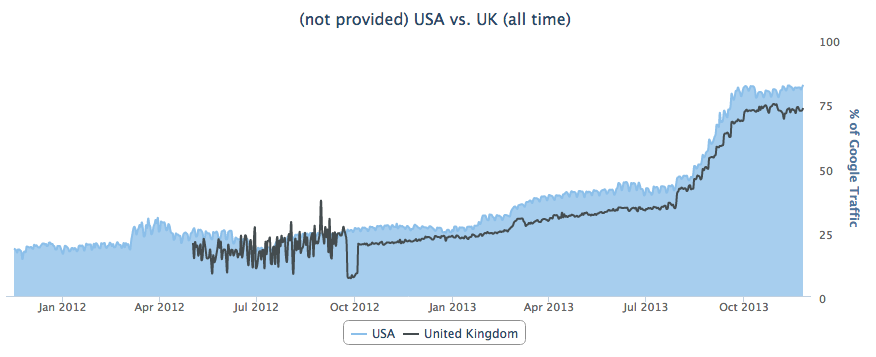As has been well documented in the SEO blogs, we’re rapidly approaching the day where 100% of the organic keyword search terms in Google Analytics will be (not provided). Google does not provide keywords for searches over SSL, which is now the default for logged in users (an ever increasing percentage with the continued push of Google+). While the cynical amongst us might view this is a hand-wavy gesture towards user privacy (keywords are still very much available to AdWords customers), the imminent loss of all organic keyword search terms has caused some severe consternation in the SEO community.

Prevalance of (not provided) today (Oct 8 2013) – Source: SERPs.com

Where we’re headed
What does this mean for Conversion Rate Optimization?
Conversion Optimization primarily deals with optimizing the conversion rate for existing traffic coming to a site. So you might think that the shift to 100% not provided keywords is much less of a problem for CRO practitioners than our SEO colleagues.
While this is largely true, there are some implications for conversion optimization as well. These include being mindful of keyword considerations when doing on page optimization, measuring conversion rates, and the use of keywords in understanding customer intent.
Don’t break the Page Rank
At FunnelEnvy when we’re working on page optimization we always try to keep the SEO and keyword implications in mind (title tags, headings, copy). Losing the organic keyword data makes this a more challenging but not impossible task.
Keyword data isn’t entirely going away. In a weekly whiteboarding session on the topic, Rand Fishkin suggests that much of the lost information in Google Analytics can be approximated through the intelligent combination of other data sources, including:
- Google Webmaster Tools – Although there have been some issues with accuracy and it won’t store data past 90 days, Google Webmaster Tools still retains the top search queries.
- Bing, Yahoo and other search engines
- Google AdWords
- Google Suggest, SEMRush
- Data that you have control over, including on site searches & historical data
With respect to external tools, SEMRush in particular has some powerful capabilities for keyword researchand is worth looking into, allowing you to not only continue to get organic keyword data but also analyze competitors organic and PPC keywords.
It also appears that the new analytics platform at Moz.com incorporates more sophisticated methods of inferring keyword data, including combining paid and organic search visit data and predictive analytics. In the same article Fishkin says he expects most of the other SEO analytics providers to do the same.
How are you measuring Conversion Rates?
If you have primarily been looking at keyword-level conversion rates you may have to switch to more holistic page, product or segment level conversion perspectives. That may not necessarily be a bad thing however, as keywords are just an intermediate measure of intent. At the end of the day visitors and potential customers visit pages so it’s important to understand the performance of the page as a whole and optimize accordingly.
The online marketing industry has been obsessed with keywords since the dawn of the search engine (or at least since the rise of Google). Although that’s not going away anytime soon, there’s a strong argument to be made that the focus on keywords often distract from the primary goal – creating quality compelling content for the audience or customer.
Understanding Customer Intent
Effective CRO requires a deep understanding of your customers and their motivations. Inbound keyword search terms can be useful insofar as they help reveal the intent of the customer upon visiting a page or site. But frankly if you’ve been relying solely on keyword data to reveal customer intent you’ve probably been missing the bigger picture. You’ve still got great tools at your disposal to understand your customers, including:
- Interviews & surveys – Nothing beats a live interview with a customer for qualitative feedback. Surveys with tools like Qualaroo allow you to learn more about your audience.
- Referrer – Referrers aren’t going away anytime soon in analytics, and often tell you more about your segments than keywords. Segment conversion rates based on referrer.
- Testing – Running different landing pages and measuring the results gives you concrete evidence as to what works and what does not.
Smart Companies and Marketers will Succeed
As many sites which built their presence on quality backlinks survived the recent Penguin and Hummingbird updates, I have to believe that companies that continue to create and promote quality content will continue to thrive going forward. Neil Patel makes a convincing argument that the shift towards 100% Not Provided will make you a better marketer, by focusing on the fundamentals as well as the bottom line business impact:
If you have an awesome service or product, you’re producing great content, and you’re building legitimate and relevant links, you should do fine.
Neil Patel
And that’s really what it comes down to. Leaving aside the questions about what’s motivating these changes, they are happening and happening soon. If you understand your audience, can attract them with quality content and have the ability to generate, test and measure new ideas continuously your online business will not only get through this unscathed, it will flourish.









